WMG News
Manufacturers leverage supply chain practices developed in response to COVID-19 to prepare for Brexit
The COVID-19 pandemic has affected many people across the world, one particular way includes supply chains, with some people finding they couldn’t buy essentials such as pasta or loo roll, and manufacturers had to suddenly change their strategies to ensure their supply chain during the pandemic.
There have been many challenges in the past for the manufacturing supply chain, such as the 2001 recession, SARS, 2011 Tohoku earthquake, 2016 oil crisis, and Brexit. Although there have been other pandemics such as swine flu and Ebola, the COVID-19 pandemic was nothing the modern world had ever seen before.
A survey by researchers at WMG, University of Warwick saw 249 medium to large manufacturers from food and beverage to automotive, and pharmaceuticals to electronic equipment and more industries respond to the survey about their supply chain resilience in the current state and future potential.
They found several impacts from the COVID-19 pandemic, including:
· 58% of firms are still experiencing a decrease in demand 3 months post lockdown
· 66-73% of firms have been effective to responding to increases and decreases in demand
· Buffer management, multi-sourcing and visibility were favoured over agile production networks
· Cash management and securing supply were critical initial responses to the Covid-19 crisis
· 84% of firms found their planning systems were effective, but still required human intervention
· The most apparent bottlenecks to their supply chain were people issues, such as warehouse staff being in quarantine at home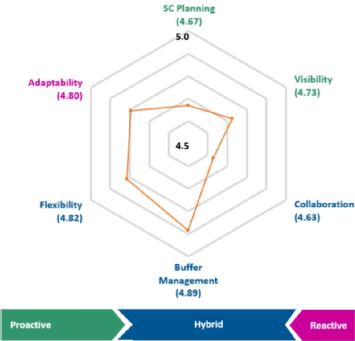
The researchers then assessed manufacturers supply chain resilience during three different times: business as normal, during COVID-19 and preparation for Brexit. For each time period they identified how 6 supply chain resilience practices that could be used proactively (pre-disruption), reactively (during and post disruption) or both. These included:
1. Supply chain planning – demand forecasting and contingency planning (Proactive)
2. Visibility – Having access to real time data (Proactive)
3. Collaboration – Working with SC partners to deliver customer value (Proactive & reactive)
4. Buffer management – Utilising inventory and production capacity to enable material flow (Proactive and reactive)
5. Flexibility – Establishing multiple sourcing options (Proactive and reactive)
6. Adaptability – Transforming the SC in responding to dynamic business environment (Reactive)
In normal operation firms found their practices to generally be effective. However, there was opportunity for improvements in visibility and collaboration to support improved supply chain planning. Firms also said they have been effective in managing buffers in normal operation.
During the Covid-19 pandemic firms utilised supply chain planning as a response to the pandemic with effective planning systems reported by 84% of manufacturers. However, this still required a high degree of human intervention. Buffer management and flexibility were found to be less effective than in normal operations. The survey found that 55% of manufacturers used inventory as their primary buffer against disruption, with only 32% utilising flexibility within the agile production systems of suppliers. Inventory buffers, whilst effective if the disruption creates an upturn in demand, can be catastrophic to cash flow if demand drops.
Similarly to COVID-19, when it comes to Brexit they’ve found that an increase in collaboration has led to improved supply chain visibility and planning. However, the uncertainty of Brexit is a cause for concern in terms of supply base flexibility with firms unsure of what type of response will be required.
Professor Jan Godsell from WMG, University of Warwick comments:
“It’s interesting to see that the lessons manufacturers have learnt in developing supply chain resilience practices in response to COVID-19 pandemic are helping manufacturers to prepare for Brexit. However, the uncertainty of Brexit, particularly in terms of the impact of flow of material is challenging for developing supply base flexibility. Whilst manufacturers can proactively prepare for Brexit, a high degree of adaptability will be required to buffer against the unknown.
“All manufacturers should consider assessing their current level of supply chain resilience to identify the areas in which their current supply chain resilience practices could be developed. Working collaboratively with supply chain partners to improve supply chain visibility and planning are the key building blocks. More effective use of inventory and capacity buffers, and flexibility within the supply base can further improve resilience. Some disruptions cannot be predicted, and supply chains need to the capability to adapt.”
UK plastic recycling company receives £4.42m Government funding from Innovate UK for ground-breaking advanced recycling plant in the North East England
Advanced recycling company ReNew ELP, based in Teesside, has been awarded a £4.42 million grant from Innovate UK, the UK’s innovation agency, to build the world’s first commercial-scale plastic recycling plant using Cat-HTR™ technology. Focussing on the UK Government’s priority to drive economic growth through new technology, the award comes through the Industrial Strategy Challenge Fund’s Smart Sustainable Plastic Packaging programme. It recognises the commercial-scale feasibility of the technology and potential of the advanced recycling sector to help meet ambitious plastic recycling targets. The grant will aid ReNew ELP in the construction of the initial plant, which commences build in Q1 2021 and will see c. 80,000 tonnes of waste plastic recycled annually upon completion.
The technology, Cat-HTR™ (Catalytic Hydrothermal Reactor), uses supercritical water, heat and pressure to convert waste plastic considered ‘unrecyclable’ through traditional mechanical means back into the valuable chemicals and oils from which it was made, for use in the petrochemical industry in the production of new plastic and other materials. This helps to create a circular economy for waste plastic.
Rebecca Pow MP, Under-Secretary of State for Defra says: “The Government is committed to both clamping down on the unacceptable plastic waste that harms our environment and ensuring more materials can be reused instead of being thrown away. By investing in these truly ground-breaking technologies we will help to drive these efforts even further, and I look forward to seeing them develop and deliver real results.”
A key benefit of the Cat-HTR™ technology is its ability to recycle multi-layer, flexible plastic materials such as films, and pots, tubs and trays (PTT), considered unrecyclable through traditional mechanical recycling, and are instead sent to landfill or incineration. Vitally, new materials made from ReNew ELP’s advanced recycling feedstock are suitable for use in food-contact packaging material, a problem area for mechanical recycling systems whose products do not meet European Food Standard Agency requirements.
In line with the Government’s policy of ‘Producer Pays’, Cat-HTR™ offers a solution to producers, retailers and brand owners levied with the expected Plastic Packaging Tax, which enforces a 30% recycled content requirement for all plastic packaging in both the UK and pre-filled from overseas from 2022, alongside
Extended Producer Responsibility (EPR), which challenges those in the plastic value chain to pay the full net cost of waste material collection and recycling. Advanced recycling company ReNew ELP offers a beneficial technology to help increase the recycled content of packaging and provide a recycling solution for plastic packaging materials such as flexible films, pots, tubs and trays.
Alongside diverting plastic away from polluting the environment, the Cat-HTR™ technology represents significant overall environmental benefit. Initial independent studies have already shown that advanced recycling can reduce CO2 emissions by 1.5 tonnes for every tonne of plastic waste processed when compared to incineration. This means that the completed ReNew ELP site at Wilton will save approximately 120,000 tonnes of CO2 annually, when compared to incineration. Environmental benefits include:
· Reducing plastic pollution of the natural environment
· 1.5 tonnes CO2 emissions saving per tonne of plastic processed via advanced recycling when compared to incineration
· An increased scope of recyclable plastics, including those classed as ‘unrecyclable’
· As Cat-HTR™ is not a combustion process, it does not produce toxic by-products such as dioxins
· A reduction on fossil sourced feedstock for the manufacture of new plastics
· High yields - up to 85% of the mass of plastic is converted to hydrocarbon products
· Minimal waste is produced- impurities (colourants, additives, fillers etc.) in the plastic feedstock fall out into the heavier hydrocarbon feedstocks, which can be used in construction
WMG at the University of Warwick partner on the project, conducting detailed Life Cycle Assessments (LCAs) to quantify the benefits of advanced recycling across multiple environmental indicators.
 Dr Stuart Coles, Associate Professor of Sustainable Materials who is leading the project in WMG at the University of Warwick says, “WMG will also be investigating what materials can be manufactured from the
Dr Stuart Coles, Associate Professor of Sustainable Materials who is leading the project in WMG at the University of Warwick says, “WMG will also be investigating what materials can be manufactured from the
Cat-HTR™ output streams. We will be able to link previously difficult to dispose of plastic materials to added-value products and demonstrate their potential through our characterisation and testing facilities.”
The technology demonstrates a complementary solution to sit alongside traditional mechanical recycling to create a circular economy. It also offers those in the plastic supply chain an alternative means for disposing of their flexible and multi-layer plastic packaging, which no longer needs to be incinerated or sent to landfill but can instead be recycled. This new process goes hand in hand with efforts to reduce single-use plastic and helps to create a plastic-neutral society.
ReNew ELP Managing Director Richard Daley says: “This Grant demonstrates we are in line with Government Policy and its drive towards achieving increased recycling targets in the UK. It will increase investor confidence, help innovative technologies such as ours break through and establish the Advanced Recycling Industry in the UK, helping ReNew ELP to emerge as a global leader in plastic recycling.”
WMG Chief Engineer takes on new role at AESIN
 WMG’s Chief Engineer, Gunny Dhadyalla, has been appointed Co-Chair of AESIN’s ADAS and HAV (Highly Automated Vehicles) Workstream.
WMG’s Chief Engineer, Gunny Dhadyalla, has been appointed Co-Chair of AESIN’s ADAS and HAV (Highly Automated Vehicles) Workstream.
This Workstream focusses on enabling technology for safer and more automated vehicles.
Gunny, who works in WMG’s Intelligent Vehicles research team will work alongside the new AESIN Chair, Tim Edwards of HORIBA-MIRA, bringing extensive industry and research experience to the future development of the Workstream.
Gunny explains: “My role as co-chair will involve working together with Tim to look at opportunities for the UK electronics value chain.
“We will be responsible for shaping the activities within the Workstream, which include; Sensing, System Engineering and Control, Validation and Verification, Human Machine Interfaces and Standards and Safety - all areas where WMG and the University have high levels of capability and expertise.
“Of particular interest, for us, is to understand the role of high value manufacturing and what the HVM Catapult centres can do to progress the development of future supply chains specifically in the areas of ADAS and HAV.”
Congratulations Gunny.
WMG and Senergy Innovations Ltd launch Graphene Enabled All Polymer Solar Thermal Cell
 Solar thermal cells continue to attract much interest as they have massive potential to heat water in a cost-effective and sustainable process. To date, the efficiency of these cells has been limited as the polymers used in their manufacture are poor thermal conductors.
Solar thermal cells continue to attract much interest as they have massive potential to heat water in a cost-effective and sustainable process. To date, the efficiency of these cells has been limited as the polymers used in their manufacture are poor thermal conductors.
However, thanks to funding from BEIS (Department for Business, Energy & Industrial Strategy) a team of researchers led by Professor Tony McNally, from WMG, at the University of Warwick in partnership with Senergy Innovations Ltd have developed the first nanomaterial enabled all polymer solar thermal cell.
The thermal properties of the polymers employed are modified such that heat from sunlight can be transferred with high efficiency to heat water in a cheap and sustainable manner. The modular design of the cells allows for the rapid construction of a solar thermal cell array on both domestic and industry roofing.
The team are now working with a consortium of industry partners focused on manufacturing the solar thermal cells in high volumes.
Dr Greg Gibbons, at WMG, and his team have also produced the first prototype (1:1 scale) of the solar thermal cell fully manufactured by 3D printing. This activity has been transformative in guiding the design and critical aspects of the manufacture of the solar thermal cells.
Professor Tony McNally, Director of the International Institute for Nanocomposite Manufacturing (IINM), at WMG, University of Warwick comments:
“It is really pleasing to see several years of research activity and the understanding gained being translated in to a real world application. Our fundamental 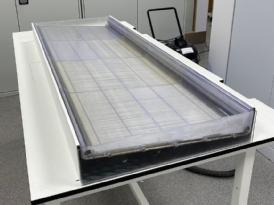 work on the thermal conductivity of 1D and 2D materials, including graphene, and composites of these materials with polymers could revolutionise the supply of affordable, clean and sustainable energy.”
work on the thermal conductivity of 1D and 2D materials, including graphene, and composites of these materials with polymers could revolutionise the supply of affordable, clean and sustainable energy.”
Christine Boyle, CEO, Senergy Innovations Ltd. adds:
“Switching to advanced polymer materials meant a more efficient manufacturing process and more flexible product design. This resulted in the breakthrough of the low cost, low carbon, lightweight smart Senergy panels. Our job now is to ensure that Senergy solar panels become a key part of the smarter built environment and make renewable heating and cooling systems affordable and accessible for everyone.”
ENDS
15 OCTOBER 2020
NOTES TO EDITORS
High-res images available at:
https://warwick.ac.uk/services/communications/medialibrary/images/october_2020/tony_m_solar_cell_testing.jpg
Caption: The solar cell as it went in for testing
Credit: WMG, University of Warwick
https://warwick.ac.uk/services/communications/medialibrary/images/october_2020/christine_boyle.jpg
Caption: Christine Boyle, CEO of Senergy Ltd with the Solar Panel
Credit: WMG, University of Warwick
For further information please contact:
Alice Scott
Media Relations Manager – Science
University of Warwick
Tel: +44 (0) 7920 531 221
E-mail: alice.j.scott@warwick.ac.uk
A circular economy could save the world’s economy post-COVID-19
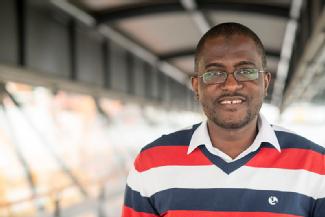
· The Covid-19 pandemic has challenged all facets of human endeavours, and seven months later the economic effects are particularly being felt
· How the world can leverage the positive and negative effects of COVID-19 to build a new, more resilient and low-carbon economy has been analysed by a group of academics led by WMG, University of Warwick
· A more sustainable model based on circular economy framework could help the world recover financially from COVID-19, whilst facilitating the attainment of net zero carbon goals
The World’s economy is feeling the effects of the COVID-19 pandemic with many industries under threat. A group of researchers from the UK, Malaysia, Nigeria, UAE and Japan, led by WMG, University of Warwick have concluded that adopting circular economy strategies would be the best way for the world’s economy to recover, whilst enabling the transition to a low-carbon economy.
The World Health Organisation declared the COVID-19 pandemic on the 11th March 2020, which saw global supply chains severely disrupted and strained, and the financial market unsettled, resulting in a cross-border economic disaster. Lockdowns and border closures shattered the core sustaining pillars of modern world economies, with the economic shock due to these measures still being weighed across the globe.
In the paper, ‘A critical analysis of the impacts of COVID-19 on the global economy and ecosystems and opportunities for circular economy strategies’, published in the journal Resources, Conservation & Recycling sees a group of researchers led by WMG, at the University of Warwick, critically analysed the negative and positive impacts of the pandemic. To make the world resilient post-COVID-19, the adoption of circular economy framework is recommended for all sectors.
The pandemic had many effects on everyone’s lives, from not leaving the house, being infected and possibly hospitalised, and even losing a loved one. It has had a strain on those who were furloughed or even lost their jobs, and the mental health of the populace. Economically, the effects can be felt everywhere due to the colossal financial loss across both the macro and micro levels of the economy, including the global supply chains and international trade, tourism and aviation and many other sectors, hampering the attainment of the United Nations Sustainable Development Goals. However, the pandemic has provoked some natural changes in behaviour and attitudes with positive influences on human health and the planet including:
· Improvements of air quality, in fact in the UK it’s thought more lives have been saved by the reduced air pollutants compared to the number of people who died with COVID-19 in China, for example.
· Reduction in environmental noise and traffic congestions has led to an increase in the number of people exercising outside to enjoy the atmosphere.
· Less tourism induced by the pandemic, resulting in less exploitation of the beaches, leading to increased cleanliness.
· Decline in global primary energy use. For instance coal use was down 8%, 60% less oil, and electricity plummeted by 20% compared to the first quarter of 2019, leading to record low global CO2 emissions.
· Triggering the need for diversification and circularity of supply chains, and evinced the power of public policy for tackling urgent socio-economic crises.
The researchers have examined the impacts of the pandemic and its interplay with circular economy, to evaluate how it could be embraced to rebuild the world’s economy.
Dr Taofeeq Ibn-Mohammed, from WMG, University of Warwick comments:
“The pandemic has highlighted the environmental folly of ‘extract, produce, use and dump’ economic model of material and energy flows, however the short term resolutions to cope with pandemic will not be sustainable in the long-run, as they do not reflect improvements in economic structures of the global economy.
“We therefore propose circular economy adoptions for all industries, with different strategies for each one. For example, embracing the transformative capabilities of digital technologies for supply chain resilience by leveraging: big data analytics for streamlining supplier selection processes; cloud computing to facilitate and manage supplier relationships; and Internet of Things for enhancing logistics and shipping processes.
“The post-COVID-19 investments needed to accelerate towards more resilient, low carbon and circular economies should also be integrated into the stimulus packages for economic recovery being promised by governments, since the shortcomings in the dominant linear economic model are now recognised and the gaps to be closed are known.”
Professor David Greenwood named as new CEO for WMG centre HVM Catapult
 WMG is pleased to announce the appointment of Professor David Greenwood, as the new CEO of the WMG centre High Value Manufacturing (HVM) Catapult.
WMG is pleased to announce the appointment of Professor David Greenwood, as the new CEO of the WMG centre High Value Manufacturing (HVM) Catapult.
Professor Greenwood will replace Archie MacPherson, who has successfully led the WMG Catapult team since 2016.
WMG Executive Chair, Margot James, said: “We thank Archie for all that he has achieved in this period and wish him all the very best as he returns to a role in industry.”
The CEO role is part of Professor Greenwood’s remit as Director for Industrial Engagement at WMG.
He currently leads WMG’s Energy Research, and also holds advisory and board positions for the Advanced Propulsion Centre, Innovate UK (Faraday Challenge and IDP and the Faraday Institution, and is Head of the Advanced Propulsion Centre's Electrical Energy Storage Spoke. Professor Greenwood also provides academic leadership for the development of R&D activities within the National Automotive Innovation Centre at the University of Warwick.
Margot added: “Dave’s passion and unrivalled experience make him the ideal candidate to lead the HVM Catapult drive to de-risk innovation in UK manufacturing, enabling its productivity, growth and sustainability.”
Professor Greenwood added : “The focus of my career has been around bringing science and technology into industry, and I am delighted that these new roles will bring together the academic strengths of WMG with the transformative capability of the High Value Manufacturing Catapult to benefit Industry and the UK. I look forward to strengthening our existing partnerships and welcoming new ones.”
Professor Greenwood will officially start as CEO from 26th October 2020.
Celebrating 40 years of WMG – from autonomous vehicle testing to digital healthcare
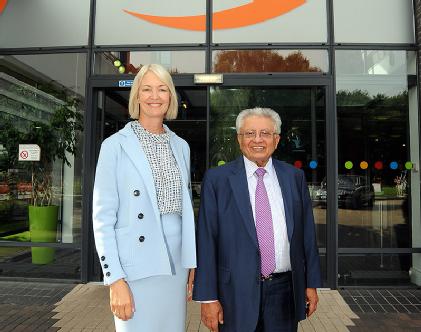
WMG an academic department at the University of Warwick was on this day, the 1st of October, 1980 started by the late Professor Lord Bhattacharyya.
Professor Lord Bhattacharyya sadly passed away on the 1st March 2019. His long and highly accomplished career in engineering and manufacturing began with his studies in Mechanical Engineering at the Indian Institute of Technology in Kharagpur, before he moved to the UK to further his studies. After working at the University of Birmingham he was persuaded by the then Vice Chancellor at Warwick, Lord Butterworth, to move to the University of Warwick where he started WMG.
Over the years he went on to become a Government adviser to Conservative, Labour and Liberal Democrat Industry Ministers and Prime Ministers.
Vice Chancellor of the University of Warwick, Professor Stuart Croft comments:
“I’m sure I speak for the whole Warwick community when I say how fantastic it is to see how Professor Lord Bhattacharyya’s vision for WMG has flourished to become not only an exceptional part of our University but also our whole region, by connecting engineering and manufacturing industries with academia. I look forward to seeing what is in store for WMG in the years ahead, as it continues to go from strength to strength.”
The new Executive Chair for WMG is Margot James, who was appointed in April 2020, comments on the achievements so far and plans for the future of WMG.
“We operate on a huge scale today but our mission and vision is the same it was on that first autumn morning. The challenges we are addressing now are different to those of 40 years ago; the need for a zero carbon industry is at the forefront of so much of our work. Our experience and expertise have never been more relevant and vital.
“Whether educating the next generation of engineers or developing the technologies that will change our world, the challenges we embrace today will shape the next chapter of the WMG story. We have the creativity, the insight, and most of all, the people to make the next 40 years of WMG even more exciting and impactful as we build a smarter, greener, cleaner and healthier world.”
Prof. Lord Bhattacharyya building shortlisted for a further three design awards
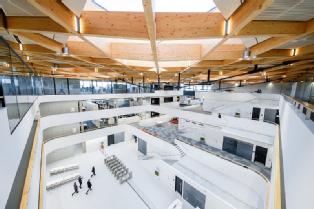 Hot on the heels of being shortlisted for the RIBA West Midlands regional awards, the Prof. Lord Bhattacharyya building, home of the National Automotive Innovation Centre (NAIC), has now been shortlisted for a further three prestigious design awards.
Hot on the heels of being shortlisted for the RIBA West Midlands regional awards, the Prof. Lord Bhattacharyya building, home of the National Automotive Innovation Centre (NAIC), has now been shortlisted for a further three prestigious design awards.
The new shortlisted awards are AIA UK Excellence in Design Award, a Wood Award, and an FX International Interior Design Award.
Based at the University of Warwick, NAIC was officially open in February 2020 by HRH The Prince of Wales. The Centre is a partnership between WMG, University of Warwick, Jaguar Land Rover, and Tata Motors, and is the largest of its kind in Europe and is well timed, arriving when a global mobility revolution is underway, with a new age for transport mobility.
A beacon for automotive research it brings together the brightest minds from industry and academia, to develop future vehicles and mobility solutions. It is home to up to 1,000 staff working across design, engineering and research, as well as future engineers on degree programmes.
Designed by Cullinan Studios the brief for the Centre was for simplicity and strength of purpose, turning a complex assembly of spaces into an immediately legible building.
WMG Professor to present at key webinar exploring The Future of Logistics
 Professor Paul Jennings will be joining the line up at The Future of Logistics, free webinar, this Friday (25th September).
Professor Paul Jennings will be joining the line up at The Future of Logistics, free webinar, this Friday (25th September).
The Future of Logistics, produced by Barclays Manufacturing Logistics and Transport team, will feature presentations by three experts on the logistics industry from the Road Haulage Association (RHA), Unipart Logistics and WMG. Professor Jennings will be sharing his expertise on connected and autonomous vehicles.
Legislation on vehicle emissions, Brexit, Covid-19, an aging workforce, vehicle autonomy and smart highways, the surge in e-commerce, and vehicle electrification are some of the biggest influencers shaping the future of logistics that will be debated.
Professor Paul Jennings, a physicist and expert in connected transport systems, will present on autonomous vehicles and also on a range of other research into transportation that can help keep goods flowing; GPS, traffic management, smart roads and cities and driver behaviour. Professor Jennings led the development of WMG’s 3xD Simulator for Intelligent Vehicles and is the current lead on Midlands Future Mobility, the £31 million public CAV (connected and autonomous vehicle) test environment.
Richard Burnett, CEO of the RHA will discuss diesel legislation, Brexit, labour and the trend of “stranded assets”, where trucks purchased by logistics firms are inoperable within a short period due to changing local regulations on vehicle emissions. Technology sector director at Unipart Logistics, Nicola Rouse, will discuss how technology is changing Unipart’s business and the new opportunities more data brings, plus the importance of sustainability and resilience in business.
Barclays’ Head of Manufacturing, Transport and Logistics, Lee Collinson, and logistics business specialist Ian Cranidge, will give an overview of their customers’ experiences of the logistics industry and where they expect improvement from operators, the government and in technology, at this challenging time.
“With the rapid rise in e-commerce before and through lockdown, plus environmental pressure on hauliers and new technology improving the intelligence of delivering goods, the logistics business is changing fast,” says Lee Collinson. “More home deliveries, Brexit, more electric vehicles and even the expected reshoring of manufacturing from Asia will put pressure on logistics operators but offer new business models too. We urge you join this free-to-attend webinar to find out more.”
A Q&A session follows the presentations where participants can put questions to the panel.
The webinar is free to attend on registration, once approved by Barclays. The event takes place at 10am on Friday 25th September.
You must register before the event, and places are first-come first-served.
Register for the event here.
ENDS
New research says Sodium-ion batteries are a valid alternative to Lithium-ion batteries
- Lithium (Li)-ion batteries (LIBs) are the electrochemical energy storage systems of choice for a wide variety of applications, however other types of emerging battery technologies are currently on the path to share their dominant position.
- Among them Sodium (Na)-ion batteries (NIBs) have great potential to represent the next generation low cost and environmentally friendly energy storage solution. The diverse key performance indicators required by different applications and the market diversification is the driving force pushing the Na-ion technology closer to the market.
- A team of scientists including WMG at the University of Warwick combined their knowledge and expertise to assess the current status of the Na-ion technology from materials to cell development, offering a realistic comparison of the key performance indicators for NBs and LIBs.
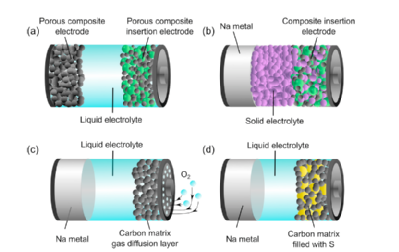 LIBs play a primary role in the transition to a low carbon economy. However, as the market rapidly expands, the environmental and social challenges associated with the mass production of LIBs is triggering large attention toward the search for alternative energy storage solutions based on materials that can be sourced in a sustainable and responsible way. In this scenario, NIBs represent an alternative low cost, sustainable and more environmentally friendly energy storage technology.
LIBs play a primary role in the transition to a low carbon economy. However, as the market rapidly expands, the environmental and social challenges associated with the mass production of LIBs is triggering large attention toward the search for alternative energy storage solutions based on materials that can be sourced in a sustainable and responsible way. In this scenario, NIBs represent an alternative low cost, sustainable and more environmentally friendly energy storage technology.
In the paper ‘Challenges of today for Na-based batteries of the future: from materials to cell metrics,' published on the 18th of September 2020 in the Journal of Power Sources, a large team of Na-ion technology expert scientists, led by WMG, at the University of Warwick (UK) analyse the prospect of NIBs taking a spot in the energy storage market. The paper also includes researchers from: Helmholtz Institute Ulm (Germany), College de France (France), Humboldt University Berlin (Germany), Institute for Energy technology (Norway), Université de Picardie Jules Verne (France), University of Bordeaux (France) and CIC energiGUNE (Spain).
Na- based batteries offer a combination of attractive properties. They are low cost, use sustainable precursors and have secure raw material supplies. In addition, they are considered as a drop-in technology which could benefit from the already existing Li-ion batteries manufacturing facilities.
As Li-based systems, Na-based batteries come in different forms, such as Na-ion, Na-all-solid-state-batteries, NaO2 and Na/S. While the last ones are seen as disruptive future technologies, the Na-ion technology represent an attractive technology almost ready to challenge the Li-ion batteries in specific applications.
Performance metrics are of utmost importance for the SIB technology to ensure a competitive cost per Wh and find a place in the market. In this work, the most promising electrode materials and electrolyte systems have been reviewed and performance metrics from the academic literature have been used to extrapolate full sodium ion cells performance indicators.
Authors indicate that with the ongoing development, the present best materials available for Na-ion cells should allow approaching the energy density of the present generation of Li-ion commercial cells. One of the most important application field for the developed sodium-ion battery prototypes is certainly stationary energy storage systems, where cost and cycle life represent two fundamental parameters. “In this field sodium-ion batteries have the potential to dominate the future market representing the most promising system to fill the gap between energy production and utilization by securing energy supply. However high-power applications in the electrified automotive field are a potential niche field application for NIBs” says Dr Ivana Hasa, Assistant Professor at WMG.
Further technological improvements are needed to increase the performance especially in terms of energy density. Extremely encouraging results have been achieved for the Na-ion technology in a very short time when compared to the Li-ion technology. Technological improvement will be achieved by cell component fabrication/assembly optimization, as occurred in the last thirty years for the LIB technology.
 Dr Ivana Hasa, from WMG, University of Warwick comments:
Dr Ivana Hasa, from WMG, University of Warwick comments:
“From an applied research point of view, the future research efforts should be devoted on fundamental research, materials discovery and understanding of the thermodynamic and kinetic processes governing the chemistry of these systems. In addition, the investigation of upscaled Na-ion batteries is of primary importance to obtain realistic data to benchmark the progress of the technology as well as the adoption of a common reporting methodology in the scientific community enabling a fair comparison among performance results.”

